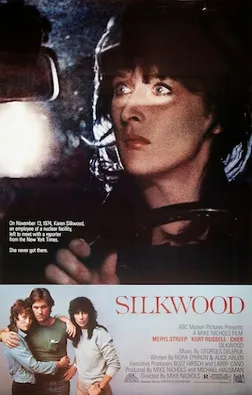Historical accuracy of Silkwood

Historical accuracy of Silkwood

Characters
Karen Silkwood
Based directly on the real Karen Silkwood. Streep's portrayal captures her spirit, activism concerning safety violations at the Kerr-McGee plant, and her personal life complexities, though some aspects are dramatized.
Drew Stephens
Based on the real Drew Stephens. The film accurately portrays their relationship and shared life, including the tensions arising from Karen's activism. The real Stephens praised the film's humanity.
Dolly Pelliker
A composite character based on Silkwood's real-life roommate Sherri Ellis and possibly another friend. Cher's portrayal captures the supportive but complex friendship, though Ellis objected to implications of betrayal.
Winston
Likely a composite or fictional character representing co-workers and relationships within the plant environment. Played by Craig T. Nelson.
Morgan
Represents officials from the Oil, Chemical & Atomic Workers union who worked with Karen. Possibly based on figures like Steve Wodka, though Wodka felt the film downplayed Silkwood's political savvy.
Angela
Represents Dolly's personal life and potentially based on real individuals, highlighting the dynamics within the shared house.
More characters
Paul Stone
Likely based on real national union officials (like Steve Wodka) who encouraged Silkwood's evidence gathering. The film depicts an affair, which Wodka confirmed occurred with him.
Max Richter
Represents Kerr-McGee management figures involved in the events and subsequent legal battles. Likely a composite or given a fictional name.
Earl Lapin
Represents plant supervisors dealing with Silkwood and the union issues. Likely a composite or given a fictional name.
Quincy Bissell
Represents local union leadership working alongside Karen at the plant level.
Gilda Schultz
Likely a composite character representing fellow workers at the plant, some sympathetic, others fearful or hostile towards Karen's activism.
Mace Hurley
Represents company officials potentially involved in surveillance or pressuring Silkwood. Played by Bruce McGill.
Story
Working at Kerr-McGee Cimarron plant
Silkwood worked at the plant making plutonium fuel rods for nuclear reactors, as depicted.
Unsafe working conditions / Plutonium exposure
Concerns about inadequate safety measures, poor training, and worker exposure to plutonium radiation were real issues at the plant and central to Silkwood's activism.
Silkwood's union activism (OCAW)
Karen Silkwood was an active member and elected leader in the Oil, Chemical & Atomic Workers union, advocating for safety improvements.
Gathering evidence of safety violations
Silkwood documented numerous safety concerns, including faulty equipment and alleged falsification of quality control records (like doctored fuel rod x-rays).
Personal plutonium contamination incidents
Silkwood experienced multiple contamination incidents in November 1974, including finding high levels on herself at work and, later, inexplicably high levels in her apartment (on food, surfaces).
Undergoing decontamination showers
The painful and humiliating decontamination showers depicted were standard procedure after significant radiation exposure. Silkwood endured these multiple times.
Company suggestion she self-contaminated
Kerr-McGee officials did suggest during investigations and the later lawsuit that Silkwood may have intentionally contaminated herself, a claim disputed by her supporters.
Trip to Washington D.C. to meet union officials
Silkwood traveled to Washington D.C. to present her concerns and evidence to national union officials.
Conflict with management and some co-workers
Her activism created tension with Kerr-McGee management and also alienated some co-workers who feared losing their jobs or distrusted her motives.
Planned meeting with NYT reporter David Burnham
Silkwood was scheduled to meet with New York Times reporter David Burnham and a national union official on the night she died, intending to give them documents proving her allegations.
Fatal car crash (November 13, 1974)
Silkwood died when her car ran off the road and hit a concrete culvert.
Suspicious circumstances of death
The film accurately reflects the unresolved questions surrounding her death. Evidence suggested potential foul play (damage to car rear, missing documents), while an autopsy found sedatives in her system.
Missing documents after crash
The documents Silkwood allegedly had with her to give the reporter were never found in the wreckage, adding to the suspicion surrounding her death.
Plant closure after events
The Kerr-McGee Cimarron plant did cease operations about a year after Silkwood's death (though the film's epilogue could imply Kerr-McGee itself closed, which it did not).
Setting
Kerr-McGee Cimarron Plant, Oklahoma
Though filmed elsewhere (primarily Texas), the sets effectively recreated the industrial environment of the plutonium fuel plant, including labs, glove boxes, and decontamination areas.
Early 1970s Time Period
Accurately captures the look and feel of rural Oklahoma/Texas in the early 1970s through costumes, cars, hairstyles, and production design.
Working-class environment
Realistically portrays the atmosphere of a blue-collar community reliant on a single industrial employer, including the social dynamics and economic pressures.
Nuclear plant interiors / procedures
Shows processes like working in glove boxes, radiation monitoring, and decontamination showers, reflecting the potentially hazardous nature of the work.
Shared house / Personal life settings
The depiction of the modest, somewhat messy house shared by Karen, Drew, and Dolly grounds the characters and contrasts with the sterile plant environment.
Union meetings / Activist environment
Represents the typical settings for union activities and the atmosphere of organizing efforts during that era.
Atmosphere of suspicion and surveillance
Effectively conveys the feeling of being watched and the potential danger faced by Silkwood due to her whistleblowing activities.
